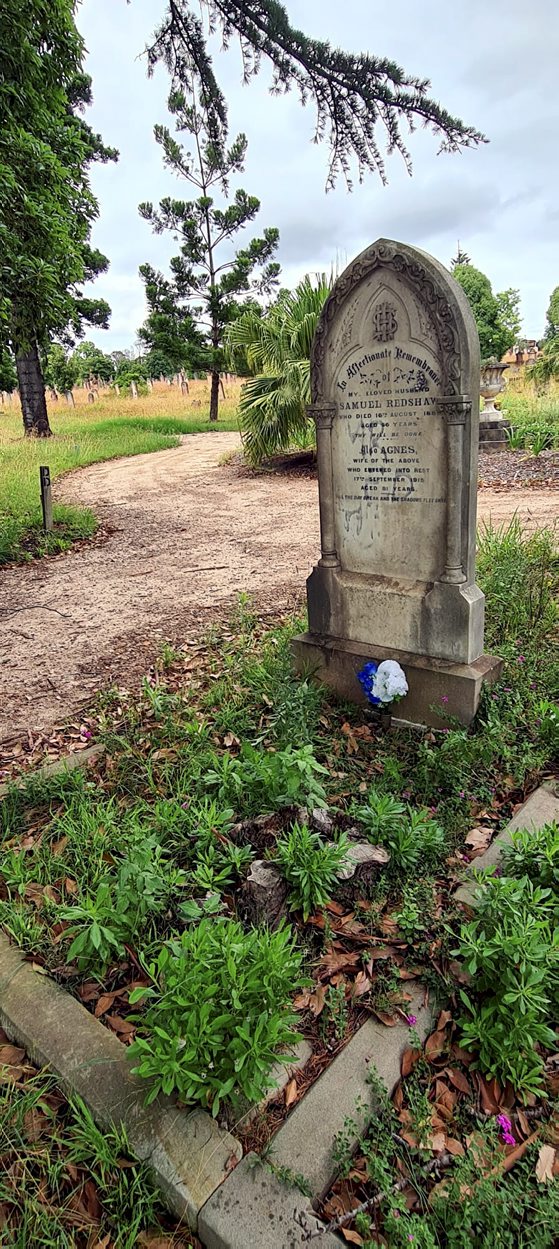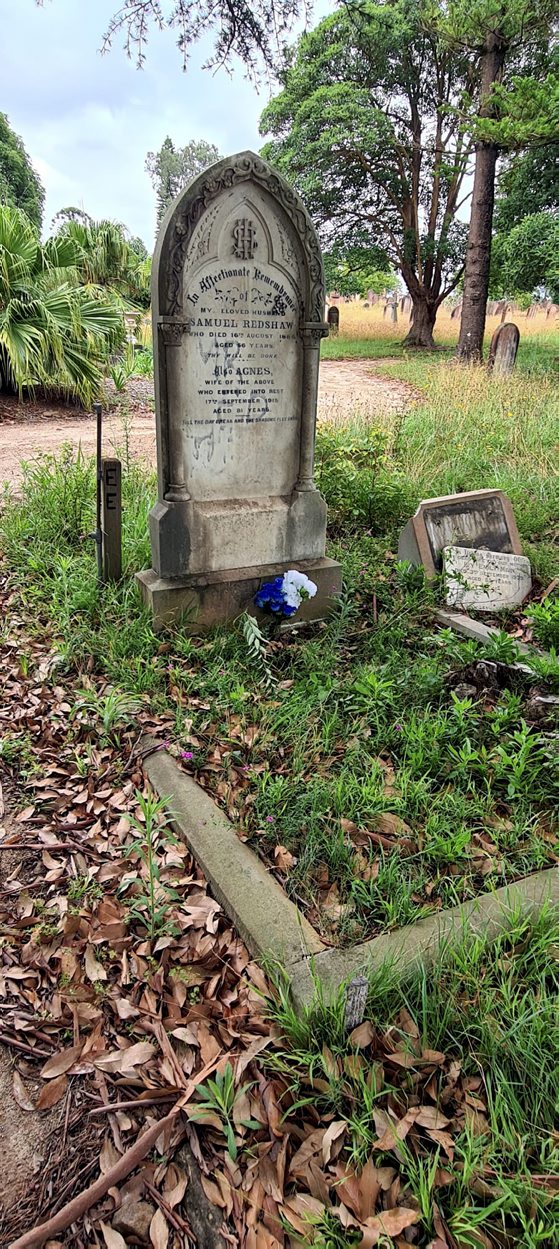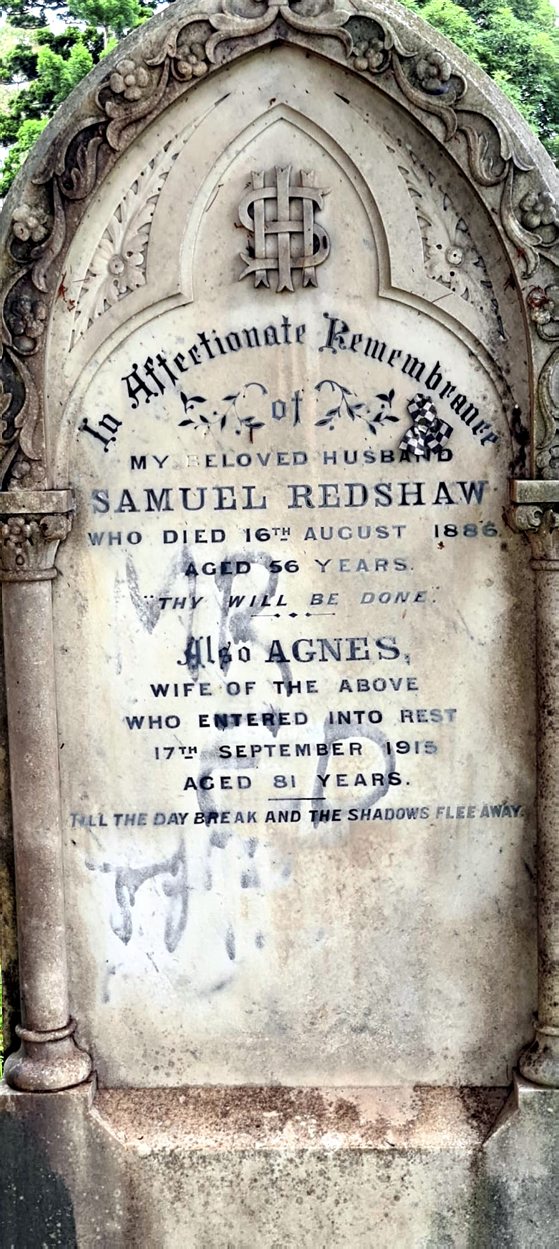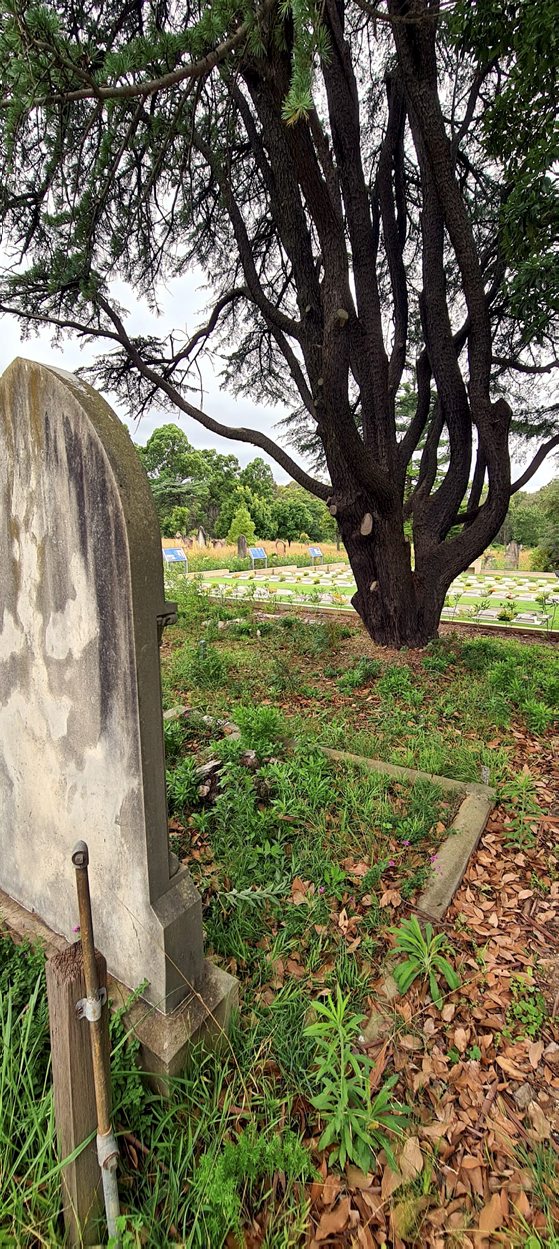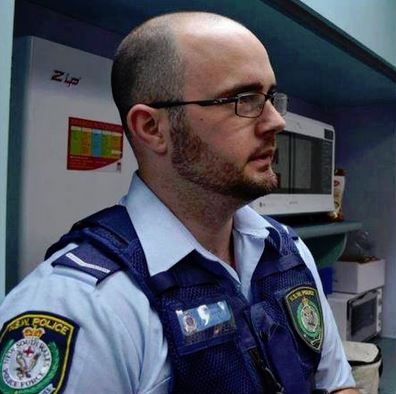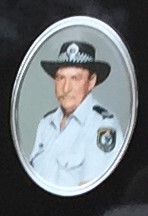Samuel REDSHAW
Samuel REDSHAW
AKA ?
Late of ?
New South Wales Police Force
Regd. # ‘ P ‘ 245
For the purposes of this website ‘P’ = represents those Police joining Pre 1 March 1862 when NSWPF “Officially” commenced.
Rank: Probationary Constable- appointed 26 July 1855
Constable – appointed ? ? ?
Constable 1st Class – appointed ? ? ?
Detective – appointed ? ? ?
Senior Constable – appointed 1 March 1862
Sergeant – appointed ? ? ? Is named as a Sgt in 1860
Final Rank = Sergeant / Senior Constable ?
Retirement / Leaving age: = ?
Stations: ?, ‘ D ‘ District ( Sydney Metro )( SenCon )( 1862 ), Sydney Police Force ( 1860 )( Sgt ), Eastern District – ‘ E ‘ Division – Liverpool ( Oct 1862 )( SenCon ), Ryde – ( 28 March 1883 )(SenCon ), Lock-Up-Keeper – Eastern District – ‘ E ‘ Division- Church St – Parramatta ( 1886 )
In articles of 1860, he is referred to a number of times as a Sgt.
On 24 September 1862 was a Senior Constable at Liverpool.
In October 1862 he is referred to as a Senior Constable at Liverpool as being an Inspector of Slaughter houses.
On 23 July 1869 – Mr Samuel Redshaw appointed Agent for the Sale of Crown Lands for District of Liverpool.
On 24 February 1870 – appointed Clerk of Petty Sessions – Liverpool ( SenCon ).
On 7 June 1870 Mr. Samuel Redshaw to be Registrar of Small Debts Court – Liverpool.
On 26 February 1874 he is mentioned as Senior Constable in Charge of Liverpool Police Station.
Service: From 26 July 1855 to 18 August 1886 = ? years Service
Former Farmer
Awards: No Find on Australian Honours system
Born: 1832 – Derbyshire, England
Died on: Monday 16 August 1886
Age: 56 years
Cause: Unknown
Event location: Police Station residence, Church St, Parramatta, NSW
Event date: ?
Funeral date: Wednesday 18 August 1886
Funeral location: Church of England Cemetery, Rookwood Cemetery, Rookwood, NSW
Funeral Parlour: White & Metcalfe, Undertakers
Buried at: Rookwood Cemetery, Lidcombe, NSW
Grave location: Old Anglican Section, EE, Zone B, plot # 183
GPS:
33°52’01.1″S 151°03’11.5″E
-33.866970, 151.053185
[codepeople-post-map]
Memorial / Plaque / Monument located at: ?
Dedication date of Memorial / Plaque / Monument: Nil – at this time ( January 2021 )
SAMUEL is NOT mentioned on the Police Wall of Remembrance *NEED MORE INFO
FURTHER INFORMATION IS NEEDED ABOUT THIS PERSON, THEIR LIFE, THEIR CAREER AND THEIR DEATH.
PLEASE SEND PHOTOS AND INFORMATION TO Cal
May they forever Rest In Peace
https://www.facebook.com/groups/AustralianPolice.com.au/
https://www.facebook.com/NSWFallenPolice/
https://www.facebook.com/groups/NSWFallenPolice/
Australian Police YouTube Channel
Empire (Sydney, NSW : 1850 – 1875),
Friday 10 August 1855, page 1
MISCELLANEOUS.
NOTICE.- We, the undersigned, having been induced to leave our native country by the representations and promises made to us to serve as a police force at Sydney, New South Wales, we now find we cannot have those promises realized, and without which our position would be much worse here than in England.
And we feel we have been treated by the police authorities with such harshness and severity, and harassed by ( we were going to say ) legal proceedings – but which will be found to be illegal proceedings – that we have determined on taking such employment as we can procure.
We are further noticed that, on Saturday next, we are to be put on shore to seek lodgings where we can.
We have, therefore, determined to appeal to the public for prompt employment in our respective callings, and we are willing to accept service at moderate wages in Sydney, or in the country, as may be required.
We are assured by our legal adviser, Mr. Ryan Brenan, of the firm of Brenan and Russell, that parties employing us do not run the slightest risk, and we are willing to allow our wages to accumulate, for a reasonable time, to protect our employers, should they entertain any doubt on the subject.
We shall attend at the office of Mrs. PAWSEY, Registry Office, No. 60, Castlereagh-street, on SATURDAY and succeeding days, to meet applicants, and to produce our testimonials of character, &c.
Names, – Trade or Calling.
George Browne. Gardener
Richard Eades . Experienced Butcher
Robert Roe. Farm Servant
Donald Finlayson . Road Maker or Agricultural Labourer
John Gibson . Agricultural Labourer
William Craik . Kitchen Gardener
Edward Quinn . General Servant
Charles Harris. Shepherd
James Clifford . Machine Sawyer
Michael Prendergast . Groom and Horsebreaker
Joseph Peake. Groom and Coachman
Neil Buchanan. Farm Servant
James Hurley . Gardener, House, or Farm Servant
John Smith. Farm Servant
David Stuart . General Labourer
Allen McDurard, . Agricultural Labourer
Henry Hogg .Herdsman
Michael Higgins . Quarrymann
James Whitehall . Groom and Horsebreaker, or Coachman
Thomas McGregor . Shepherd
James Fairley . Agricultural Labourer
Patrick Maher . General Servant
James Levick. Woollen Weaver
William Elder . Farm Servant
Thomas Hand . Shepherd or Ploughman
Henry Kerr . Agricultural Labourer
Thomas Harris . General Labourer
Patrick Bryan . General Labourer
William McNish . General Labourer
Donald McMullen . Stoker
Patrick Levy . Farm Steward
Noble Handcock . Agricultural Labourer
Charles Woodhouse . Agricultural Labourer
Thomas Hegarty . General Servant or Coachman
William Roarke . General Servant or Coachman
Donald Sutherland . Herdsman
James Kennedy . Ploughman
Alexander Cohoon . Agricultural Labourer
John Blagbourn . Gardener and Sheepshearer
James Nichols . Gardener and Sheepshearer
John Holroyd . Woolsorter
Mathew Warburton . Agricultural Labourer
William Gough. Farm Servant
James Keenan . Farm Servant
Francis Keenan . Groom
Henry McLaren . Hotel Porter
Patrick Loughnan . Ploughman
Hugh Campbell . Agricultural Labourer
William Frederick Hitches . Gardener
William Clarke . Shepherd
Charles Robertson . Farm Servant
David Renne . Farm Servant
William Cooke . Farm Servant
Robert Fullerton . Farm Servant
Samuel Redshaw . Brickmaker
John McGregor . Farm Servant
John Grey . Farm Servant
Alexander McDonnell . Ploughman
Robert Swanson . Shoemaker
George Kennedy . Farm Servant
Patrick Lyons . Painter, Glazier, and Sign Write, or Clerk and Accountant in a Merchant’s Warehouse.
10 Aug 1855 – Advertising – Trove
Empire (Sydney, NSW : 1850 – 1875),
Saturday 11 August 1855, page 2
NOTICE. – The men named below, who arrived in this port by the ship Exodus, were engaged for, and are under agreements to serve in the police. They have refused to enter on their duties under their agreements, and the public are hereby cautioned against employing any of them, and thus subjecting themselves to the legal consequences of so doing.
W. C. MAYNE, Inspector – General of Police 10th August, 1855.
Patrick Lyons, Peter Murray, John Spooner, James Hurley, William Hitches, Robert Fullerton John Blackburne, James Levick, James Nichols, William Cook, Peter Barnes, Neil Bucchannan, Patrick Logan, John Smith, Edward Quinn, Robert Mayne, Thomas James, William Craik, Charles Sheasly, Henry Hogg, Richard Eades, John Gibson, Frederick Stukely, William McNish, Samuel Condick, Thomas McGregor, George Brown, William Clark, Joseph Howard, Charles Robertson, Thomas Hegarty, Francis Keenan, Jeremiah Phelan, James Keenan, Henry Kerr, David Rennie, Robert Rea, Robert Swanson, Michael Higgins, Patrick Meagher, Charles Woodhouse, James Fairley, Michael Prendergast, Hugh Campbell, James Whitehall, Thomas Hand, Joseph Peaker, Alexander Colquhoun, Matthew Warburton, Alexander McDonald, Samuel Redshaw, Hugh McLaren, William Gough, John McGregor, John Holroyd, James Gray, Thomas Harris, David Stewart, George Kennedy, Donald Finlayson, Patrick Bryan, John Clifford, Richard Fawcett, James M. Kennedy, Walter Murray, William Elder, Charles Harris, John Lawton, William Sutton, William H. Gill.
11 Aug 1855 – Advertising – Trove
Sydney Morning Herald (NSW : 1842 – 1954),
Friday 19 December 1856, page 8
THE BALLOON RIOT IN THE DOMAIN
DEATH OF THOMAS DOWNS.
The boy Downs having died in the Infirmary on Wednesday morning from injuries received on Monday afternoon, by the falling of one of the upright poles erected in the Domain for the purpose of sustaining the balloon of M. Pierre Maigre during the process of inflation, an inquest was held on his body, shortly after mid-day, at the Three Tuns, King-street, before Mr. J. S. Parker and a jury of thirteen. John Kelly, Edward Atkinson, and Joseph Prior, three seamen of H.M.S. Juno, who were brought up at the Central Police Court on Tuesday, for riotous conduct in the Domain on the previous evening, and had been remanded till Friday, were brought before the Coroner in custody, it having been alleged that they took an active part in knocking down the pole which inflicted the deadly wound on the deceased boy.
The first witness examined was Emanuel Benjamin, residing in Clyde-street, Miller’s Point, who deposed that deceased, Thomas Downs, was his stepson, and that he was about eleven years old. Deceased obtained permission from his mother on Monday to go to the Domain to see the balloon ascent ; he was to return in an hour, but did not ; went to the Domain at 10 o’clock at night to seek for him ; then heard that two boys had been hurt, and taken to the Infirmary ; on enquiry there, found that his step-son was one of them ; identified, the body lying dead at the Infirmary as that of his wife’s son.
Donald McIntosh McEwen, a duly qualified medical practitioner, stated that, on Tuesday morning, between 9 and 10 o’clock, he made his usual visit to the Infirmary, and then saw the deceased, who had been attended immediately after the accident on the previous evening, by Drs. Nelson and McFarlane, in conjunction with the house surgeon ; examined deceased, and found him in a state of insensibility, with a very serious fracture on the left side of the head, extending from the forehead to the vertex ; about the vertex there had been several pieces of bone removed ; from the substance of the skull saw the place they had been taken from ; produced the pieces ; the injury he described would be quite sufficient to cause death, and such an injury would be inflicted by one blow from a heavy substance ; there was a clean cut extending from about the middle of the frontal bone to the vertex ; there was no coagulated blood on the surface of the skull ; the wound must have bled freely; a stick in the hand of a powerful man would make such a wound and fracture on a child of such tender years. On being recalled, the same witness stated that there were no other marks of violence on the body but the one he had described ; the evidence he gave was from what he bad seen, not from anything he had heard.
William Mortimer, inspector of the police force, and in charge of the C division, was next examined, and detailed at some length the riotous proceedings he had witnessed ; his attention was particularly called to some sailors belonging to H.M.S. Juno, forcing themselves over some iron fencing round the balloon ; he remonstrated with them, and got them to go back again ; about 7, when the balloon become inflated and rose two or three yards in the air, a rope fastened to the top of it became entangled ; some one cried out ” Cut the rope ;” M. Maigre was at that time in the car attached to the balloon ; it began swaying about, and the gas was escaping ; saw some sailors and soldiers, with other parties, pulling the balloon down ; his attention was called to a great number of persons rushing towards a tent in which the Governor and his suite had been sitting; followed and saw M. Maigre running, with a body of police around and protecting him, to get away to a place of safety ; on returning to the spot where the balloon was, having been away about four or five minutes, found the enclosure full of people, and among the most prominent saw some sailors of H .M. S. Juno, and some soldiers, who had surrounded and got hold of Captain McLerie, the Inspector-General of Police ; noticed the prisoner John Kelly; he, with other sailors, was pulling the balloon towards the fire, and they eventually burnt it ; saw the same prisoner most active in pulling down a tent in which the spirits of wine had been kept ; it was also destroyed ; about an hour after his attention was called to the same prisoner, who was engaged with other sailors destroying the fencing, chairs, and seats, throwing them into an immense fire ; Captain McLerie and he did all they could to prevent mischief ; he had been roughly handled, and threatened to be thrown into the fire by Kelly and others ; saw one of the poles pulled down with a great crash ; didn’t know by whom it was done ; also saw the second pole come down, a few moments after ; the sailors appeared to be a little groggy ; there might have been eight or nine of them ; had no doubt as to the identity of Kelly ; he was taken into custody and removed to St. James’ watch-house, where witness identified him as the leader of the mischief ; from the density of the crowd was surprised that so few people were injured by the falling of the poles.
William Hamilton Galbraith, a medical practitioner, had been in the Domain on Monday afternoon ; saw a machine miscalled a balloon, suspended from two pair of spliced poles ; saw it burned, together with a tent and its contents ; saw a soldier of the 11th upset an iron furnace in which was some ignited straw ; some sailors and others drew the balloon across the fire and set it in a blaze ; the tallest prisoner was the most conspicuous amongst them ; saw the poles pulled down by several persons whom he did not know ; there were boys and a woman among them assisting in pulling, and crying out cut the ropes ; took particular notice of the prisoner ; be ran bodily against the pole as soon as the ropes were cut, and by his main force shoved the pole down ; when the pole fell, heard a scream, and cries of Oh ! Oh ! ran to see what had happened ; found two boys lying, one with a severe cut in the head and quite insensible ; examined the wound and found there was a fracture of the skull, about four or five inches long : it was bleeding very much ; he breathed heavily ; heard afterwards that he was taken to the Infirmary ; did not see the prisoner cut any rope ; the poles would not have fallen had the ropes not been cut ; saw sailors, or men dressed like sailors, drawing out sheath knives about the pole ; immediately afterwards the ropes were adrift.
By the prisoner : At what time did you see me ? Answer : About seven o’clock. Had no doubt as to the identity of the prisoner.
Robert Hobbs deposed that he went to the Domain on Monday morning about half-past six with tents for the accommodation of visitors, and remained there till ten at night ; identifies the prisoner Atkinson ; saw him kick the furnace, and some sparks flew from it ; he did not kick it over; at the same instant the mob around said set fire to the balloon, which was no sooner said than done ; prisoner drew the balloon to the fire and set it alight, then drew it to the tent, with the assistance of Kelly and others, and set fire to the tent. The witness next described the pulling down of the poles ; the prisoner Atkinson let go the guys ; could have seen clearly had any one pushed at the pole when it fell ; did not see any one pushing it ; saw a soldier or marine about at the time the balloon and tents were burned ; he took a very active part in it ; did not see the second pole fall, nor did he hear any one call ” Get out of the way” before the first pole fell ; saw a man dressed as a sailor of the Juno, who was pockmarked; he took an active part in pulling down the poles ; could identify him.
By the prisoner Atkinson ; It was between half past 7 and a quarter to 8 that he saw the prisoner at the balloon ; recognised the prisoner by his dress and present appearance; he was a little excited from drink ; saw no sheaths or knives with the sailors.
George Nelson spoke generally as to the conduct of the crowd, and from the falling of the poles, from the position the boy was in, did not think he could have had anything do with the pulling at the pole which fell on him ; saw no one shove the pole, nor did he recognise the sailors now present as being there ; several sailors were throwing chairs and other things on the fire ; saw sailors with others pulling on the ropes, but did not see them do more than others did ; gave the alarm to the police that a boy was killed ; could not identify a single individual that was there.
At this stage of the proceedings, the enquiry was adjourned until next day ( Thursday ), at 12 o’clock, and the jurors bound over in the sum of £20 each for their appearance.
SECOND DAY.
Yesterday, at noon, the inquest was resumed at Mr. Driver‘s, King-street.
Mark Levy, furniture dealer, George-street, examined : Went to the Domain at 4 o’clock to see the balloon ; saw some men-of-war sailors there, who were the worse for liquor ; recognised the two shortest prisoners now before the Court as the men ; saw the sailor Atkinson pulling away the other, who gives his name as Prior, and persuading him to come away ; Prior wanted to fight some one ; they were disposed to be quarrelsome, and persuaded them to go away ; then saw Atkinson and Prior go out of the gate ; did not see them go near the pole ; it is possible that they might have got back to the pole without his seeing them ; saw lots of boys there, and it was his opinion they did most mischief ; was almost positive that the seamen now before the Court had no hand in pulling down the poles ; believed the people were quite as much excited as the sailors ; followed the body of the boy, and as he got outside the gate, saw the prisoner Kelly standing talking to some other sailors ; this might have been about 200 yards from the pole ; it is possible he might have come from the pole after it fell ; thought however, that he did not ; cannot say whether he was in liquor or not.
By a Juror : Was within a few yards of Atkinson when prisoner pulled him away.
By the prisoner Atkinson : Saw him first about four o’clock.
Samuel Redshaw, a police constable, stated that he did not see the first pole pulled down ; saw the second, however ; the prisoner Kelly was pulling a rope attached to it, and calling for help ; was about ten yards from him ; many civilians were assisting equally as bad as the sailors.
James Burt, sergeant of police, detailed the burning of the balloon, chairs, &c. With reference to the pulling down of the poles, he stated that there were civilians, as well as sailors and soldiers engaged in the work ; believes he saw the prisoner Prior there doing as the mob did ; the prisoner Kelly was not there to his knowledge ; had he been, thinks he must have seen him ; although he said that sailors and soldiers took an active part in the affray, he meant that they were more prominent by their dress ; the people were quite as much engaged as they.
William Carruthers, civil engineer, residing in Woolloomooloo, was in the Domain on Monday afternoon. His evidence presented no new feature, the chief point in it being, that before the pole came down a general shout having previously been given that it was falling, and to look out for it – it was almost impossible to say who was to blame in the matter, as it seemed a general thing. Dr. Duigan informed witness, after he had examined the boy, that he ( Thomas Downs ) could not live. Did not, on Monday, see any of the prisoners then before the Court.
This closed the evidence, and the jury shortly after returned the following verdict :- ” That the deceased, Thomas Downs, aged 11 years, came to his death by the falling of a pole in the Domain, on Monday evening the 15th instant, which was thrown down by a disappointed and excited crowd of people, out of whom it is impossible to single out any individuals as the ringleaders, or as throwing down the poles ; and we unanimously consider that, if any person is to blame, it is Monsieur Maigre, the perpetrator of the sham balloon ascent, which we consider caused the death of the said boy. We wish this to be considered a censure upon Monsieur Maigre. ”
19 Dec 1856 – HE BALLOON RIOT IN THE DOMAIN DEATH OF THOMAS DOWNS. – Trove
Sydney Morning Herald (NSW : 1842 – 1954),
Thursday 6 January 1859, page 8
ELECTORAL LISTS.- Notice is hereby given, that at a Meeting of her Majesty’s Justices of the Peace acting in and for the Police District of Sydney, holden at this office on the 31st of December last, and 1st of January instant, the following persons were duly appointed Collectors of the Electoral Lists within tho Police District of Sydney, under the Electoral Act of 1858, for the several electoral districts in connection with their respective names, viz. :
EAST SYDNEY.- Inspector James Singleton, Sergeants Charles Smith, Jeremiah Stale, William Sutton, and John Taylor, and Constables Matthew McKeogh, William Cook, William Fairland, and Roger Fenton.
WEST SYDNEY– Inspector George Reid, Sergeants Richard Lee and Edward Sweney and Constables Edward Bloomfield, Anthony Hargrave, Peter Grimley, Andrew Love, William McNish, and Samuel Condick.
CANTERBURY.- Sergeants John Nowlan, John Enright, and Denis Linane, and Constables Thomas Hanly, John Emerton, James Hart, William McNamara, and Charles Harris.
GLEBE AND BALMAIN.- Inspector Wm. John Weston, Sergeants David McMakin, and John Healy, and Constable Wm. Rourke.
ST. LEONARD’S.- Inspector Thomas Ferris Quirk, Sergeants George Lamont and Thomas Joyce, and Constables John Hiatt, John Sheaves, Stephen Whelan, Henry Blaber, Patrick Kelly, and Patrick Malone.
NEWTOWN.- Sergeant Peter Conway, and Constables John Ibbotson, James Fairley, and John Carroll.
PADDINGTON, SURRY HILLS, AND REDFERN.
Inspector James Black, and Sergeants Henry Hogg and Samuel Redshaw, and Constables Thomas McKenzie, Edward Slattery, and William Cook.
It is particularly requested that all persons entitled to vote under the new Electoral Act in the said districts will afford the necessary information, and otherwise facilitate the duties of the collectors, and the proprietors of unoccupied lands or other property in the rural districts of Sydney are invited to communicate with the collectors, in order that their names may be inserted in the Electoral List in respect thereof.
By order of the Bench of Magistrates,
GEO. WARBURTON, Clerk of Petty Sessions.
Central Police Office,
Sydney, 5th January.
06 Jan 1859 – Advertising – Trove
ydney Morning Herald (NSW : 1842 – 1954),
Thursday 9 February 1860, page 3
SECOND COURT.
Before Mr. Justice Milford.
INDECENT ASSAULT OF A CHILD.
Patrick Connery, indicted at the last sittings, was placed in the dock to stand his trial for that he, at Paddington, on the 13th day of October, 1859, did unlawfully and indecently assault one Mary Ellen Burke, a female child under the age of twelve years.
Mr. Butler conducted the prosecution against the prisoner, who was not defended by counsel.
The prosecuting counsel addressed the jury, and briefly stated to them the circumstances of the case.
Sergeant Samuel Redshaw, of the Sydney Police Force, deposed that he had arrested the prisoner on the fourteenth October last. Witness told him what was the charge against him. Prisoner said that the charge was a made up affair between the mother, the daughter, and the old woman Connolly.
The witness was cross-examined by the prisoner, but nothing of importance was elicited.
Mary Ellen Burke, the child referred to in the indictment, aged about seven years, was brought into court, but as she did not appear to have received any instruction whatever upon religion, her evidence could not be taken.
Catherine Connolly deposed that she knew the prisoner ; at the time that prisoner was arrested she was stopping at the house of Mr. Burke, the publican – the father of the little girl, Mary Ellen Burke ; witness one day went up stairs, and went into a room wherein there was only a basin stand and a box. This was three or four months ago. Mrs. Burke’s child was there, and the prisoner was also in the same room. [ Witness then proceeded to describe circumstances which amounted to a direct proof of the charge against the prisoner. ]
The prisoner had been drinking that morning, and seemed much the worse for liquor. Witness went down immediately, and told the parents ; the father questioned the child, and, on hearing what she said, struck Connery with a billet of wood when he came down stairs ; Mrs. Burke had sent witness upstairs for the child. Witness was cross-examined by the prisoner, but her evidence was not thereby affected. Cross-examined by the Judge, witness described the nature of the washhand-stand on which the child was sitting when witness went into the room ; the little girl was sitting on the top of it ; the prisoner had owed witness a pound for a long time, and witness used to ask him for it ; about a fortnight before this occurred Burke was bouncing the prisoner, and saying that he would not give up the property to him.
Mary Burke, the mother of the child Mary Ellen Burke, deposed that she remembered the day that something was done to her daughter. She was upstairs that morning with her brother ; they both once came down together : they had then some money, which the child said Paddy ( the prisoner ) had given to them ; witness was in the front room sewing, and after that sent the woman Connolly up stairs for them ; the woman came down stairs saying the child was destroyed ; witness saw her husband, just afterwards, striking the prisoner with a billet of wood; there was no difference existing between witness’s husband and the prisoner, except that Connery held a mortgage over the house. The prisoner had drunk something that morning, but was not drunk ; witness was not drunk. Cross-examined by the prisoner : witness admitted she had once been placed in gaol by her husband, and that prisoner had bailed her out ; witness had never expressed a determination to be revenged upon prisoner; the witness Connolly was drunk on that day, at the time she came down stairs, and made the statement against the prisoner Connery. The counsel for the Crown begged to withdraw the case.
The jury ( by the direction of the Judge ) returned a verdict of not guilty, and the jury intimated that the prisoner left the Court without any stain upon his character.
09 Feb 1860 – SECOND COURT. – Trove
Empire (Sydney, NSW : 1850 – 1875), Saturday 11 May 1861, page 5
WATER POLICE COURT.- Friday.
Before Messrs. S. North and J. McLean..
Sydney James Dalton was arrested by Samuel Redshaw, sergeant in the city police, charged with being in the dwelling-house of Rose Strange, for an unlawful purpose, on the 7th instant. The complainant Rose Strange, resides in Windmill-street, and only knew the defendant few days before she charged him with this offence.
It appears that he lodged in a house next door to the complainant, kept by a Mrs. Jacques, and about a quarter-past 2 a.m., on the morning of the 7th instant, the complainant was awoke by hearing a noise at the window shutters. She struck a light and saw defendant through the window, and asked him who he was and what he wanted, and he replied he would soon let her know. She went to the room in which her son slept, and roused him, and when they returned to complainant’s room Dalton was in the act of getting in at the window, whereupon, her son shoved him back, and he then went back to the house where he lodged.
On the following day, Mrs. Strange saw Dalton, and said if he apologised for what he had done, she would let the matter drop ; but he laughed, and said he was drunk at the time.
The prisoner, in defence, stated that when Mrs. Strange saw him the next day, that he said if he had been guilty of any ungentemanly act he was sorry for it.
The Bench ordered him to enter into his own recognisance in the sum of £50, to be of good behaviour for twelve months.
11 May 1861 – WATER POLICE COURT.—FRIDAY. – Trove
Sydney Morning Herald (NSW : 1842 – 1954),
Wednesday 5 November 1862, page 3
NEW SOUTH WALES PARLIAMENT.
LEGISLATIVE ASSEMBLY.
TUESDAY, NOVEMBER 4.
INQUEST AT LIVERPOOL
Mr W FORSTER asked the Colonial Secretary,
” 1. Has any communication been made to the Government, or to the Attorney General, relative to the alleged sudden and mysterious death of a man named Hart, a few weeks since, while in the service and upon the premises of Captain Moore, J P , of Liverpool ?
2. Was any inquest held upon Hart’s body, or magisterial investigation made at the time into the circumstances of Hart’s death ?
3. If so, by whom, when, and where?
4. Was there any post mortem examination, or was any – and, if any, what – medical man present at such inquest or investigation ?
5. What was the result?
6. Has any further enquiry been ordered, or is any intended, by the Government ?
Mr COWPER answered generally, that a communication was addressed to the Government and a magisterial inquiry held, the result of which he held in his hand, in the form of a police report.
It was as follows – ” John Hart, aged seventy-two, labourer, place of death, Asylum, Liverpool.
The deceased has been in the employ of Samuel Moore, Esq, J. P., Liverpool, for many years, but for some time past was not able to do much work.
He was very much addicted to drink, and on last Monday he got drunk, and a man named George Fagan gave him a slap on the face for making a noise in the yard, afterwards putting him into an outbuilding to sleep.
Yesterday morning, Captain Moore sent for me for the purpose of giving the deceased into custody for protection.
I saw that the deceased was very ill, and I sent a constable to Dr Smith for an order for his admittance into the Asylum. Dr Smith gave an order, and I had him removed there immediately, and he died this morning.
Dr Smith made a post mortem examination, and found that he died from apoplexy, and that the slap on the face did not hasten his death.
Samuel Redshaw,
245,
senior constable,
24th September, 1862 “.
The hon. Colonial Secretary stated further that, in consequence of a letter sent by Mr. Charles Luke Bayly, a second investigation was held before Mr Jones and another magistrate, with a similar result – the medical evidence proving death to have been caused by sanguineous apoplexy, and in no way brought about by the slap or blow which the deceased received.
https://trove.nla.gov.au/newspaper/article/13236635
Sydney Morning Herald (NSW : 1842 – 1954),
Thursday 26 February 1874, page 7
Two PERSONS DROWNED BY FLOOD WATERS.-
The Coroner of Parramatta and Liverpool held an inquest at the Court-house, Liverpool, on the 24th instant, on the body of a man named Sidney Baldwin.
Samuel Redshaw, the senior-constable in charge of the Liverpool Station, deposed that at daylight on the 24th instant, he was in company with Mr. Thomas Thorn, searching for the body of deceased at Heathfield, about eight or nine miles down the George’s River, and found it in a paddock lying face downwards ; it was wet and covered with mud, and appeared to have been left by the flood waters as they receded ; it was then about 6 o’clock a.m. ; had the body brought to the police station.
Dr. Strong deposed that he had externally examined the body, and found it to present all the indications of death from drowning.
Thomas Thorn, farmer, Heathfield, deposed that he and deceased a little after daybreak on the 23rd instant started together on horseback towards a ridge, where some of witness’s cattle and horses were standing in the flood waters ; their horses got into a hole, and threw them both off into deep water ; both swam for it, holding their horse’s bridles; deceased said to him, ” I must let my horse go, it will be drowned ; ” witness then took both horses himself ; when he got standing ground he looked round for deceased, but he had disappeared beneath the water.
William Hart, a seaman, identified deceased as a shipmate of his by the Strathnaver, from England, in November last ; deceased came out as an able seaman, was 23 years of age, and a native of Manchester, England, where he had friends.
Verdict- ” Accidentally drowned. ”
https://trove.nla.gov.au/newspaper/article/13332249
Sydney Morning Herald (NSW : 1842 – 1954),
Saturday 2 May 1885, page 1
Marriages
REDSHAW—SUTTON.—April 15, at the residence of the bride’s parents, 45, Princes-street, by the Rev. W. G. Taylor,
Thomas, eldest son of Samuel Redshaw, of Parramatta, to Margaret, youngest daughter of William Sutton, of Sydney.
https://trove.nla.gov.au/newspaper/article/13587681
Sydney Morning Herald (NSW : 1842 – 1954),
Tuesday 17 August 1886, page 14
Funerals
The Friends of the late Samuel REDSHAW, Senior-Constable of Police, are respectfully invited to attend his Funeral ; to move from his late residence, Police Station, Parramatta, at 2 o’clock, on WEDNESDAY AFTERNOON, for Rookwood Cemetery.
WHITE and METCALFE,
Undertakers.
https://trove.nla.gov.au/newspaper/article/13644313
Sydney Morning Herald (NSW : 1842 – 1954),
Tuesday 17 August 1886, page 1
REDSHAW.—August 16, 1886, at his residence, Police Station, Parramatta, Senior-Constable Samuel Redshaw, leaving a sorrowing wife and nine children to mourn their loss ; aged 56 years.
https://trove.nla.gov.au/newspaper/article/13644236
New South Wales Government Gazette (Sydney, NSW : 1832 – 1900), Tuesday 24 August 1886 (No.475), page 5733
In the Supreme Court o£ New South Wales.
In the estate, goods, chattels, credits, and effects of Samuel Redshaw, late of Parramatta, in the Colony aforesaid, senior constable and watch-house keeper, deceased, intestate.
NOTICE is hereby given that after the expiration of fourteen days from the publication hereof, application will be made to this Honorable Court, in its Ecclesiastical Jurisdiction, that letters of administration of all and singular the estate, goods, chattels, credits, and effects of the abovenamed Samuel Redshaw, deceased, who died on the 16th day of August, 1886, may be granted to Thomas Redshaw, of Dowling-street, Sydney, in the said Colony, grocer, the eldest son of the abovenamed deceased.— Dated this 21st day of August, a.d. 1886.
ROBERT HENRY LEVIEN,
Proctor for the said Applicant,
George-street, Parramatta, and Phillip-street, Sydney.
5947 6s. 6d.
https://trove.nla.gov.au/newspaper/article/222754844
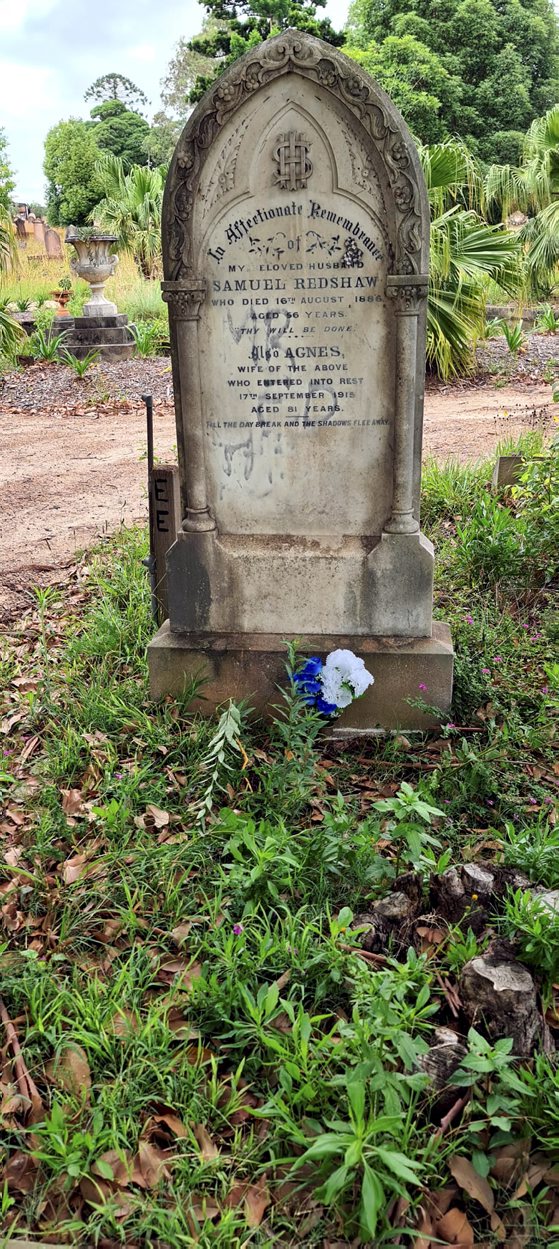
Grave location:
Old Anglican Section, EE, zone B, plot #183. GPS -33.866970, 151.053185.
Nothing further, than what is recorded above, is known about this man at the time of publication.
Cal
